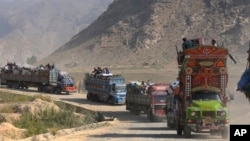Afghanistan’s ruling Taliban said Tuesday that about 3.7 million former refugees have returned to the country since the Islamist group took power three years ago. The statement was a response to the International Organization for Migration, or IOM, which reported last week that more than twice as many Afghans have left the country since 2020.
Which side is correct? Possibly both.
The dispute began with a July 31 IOM report that said “nearly 8 million Afghans” have departed the country over the last four years.
Of those, said the IOM, 85% moved to neighboring countries, mostly Iran and Pakistan, and almost 1 million headed to Europe. The IOM said almost 70% of Afghans who went to Iran cited a lack of job opportunities as the main factor driving their migration.
The Taliban-run Ministry of Refugees and Returnees challenged the IOM figure, saying there has not been such a significant exodus of people from the country since the Soviet invasion and subsequent decade-long occupation of Afghanistan in the 1980s.
"In the last three years alone, 3.7 million Afghan citizens have returned home, marking the first instance of such a substantial influx in the last 40 years in Afghanistan’s history,” the ministry declared.
The ministry accused the U.N. agency of issuing false and misleading figures to attract donor funding.
While neither side’s figure can be independently confirmed, it’s conceivable that both numbers are accurate.
Afghanistan has experienced significant outflows and inflows of people this decade. Many Afghans flee turmoil sparked by the withdrawal of the U.S.-led anti-terrorism coalition and the return to power of the Taliban, who continue to battle Afghan insurgent groups as well as sanctions imposed by Western countries over human rights concerns, mainly laws that ban women from most aspects of public life.
At the same time, many Afghans are getting a cold welcome in what they hoped would be countries of refuge. In its report, the IOM acknowledged that the number of Afghans repatriating from Iran “remains consistently high.” It stated that nearly 1 million Afghans came back home in 2023, with “70% being undocumented and 60% forcibly returned.”
Meanwhile, neighboring Pakistan reported this week that its crackdown on undocumented foreigners in the country has led to the repatriation of nearly 700,000 Afghans in the last 10 months. Another 1.4 million legal Afghan refugees remain in the country.
IOM and its partner agencies have repeatedly urged all countries to “immediately halt the forced returns of Afghans, both in the short and long term, until conditions are established to ensure safe, dignified, and voluntary returns, regardless of legal status.”
Climate change impact
Meanwhile, Save the Children reported Tuesday that extreme weather events forced at least 38,000 people, about half of them children, from their homes in Afghanistan in the first six months of this year.
The aid group said, “While most displacements in recent decades have been due to conflict, in 2022, climate disasters became the main reason people fled their homes and moved to other areas within Afghanistan.”
The report noted that more than one-third of Afghans are facing crisis levels of hunger, driven mostly by climate shocks and high food prices.
Recent U.N. reports have cited drought as the main reason for disaster-driven displacement in Afghanistan, ranked as the sixth most vulnerable country to the impacts of climate change. The assessments found that 25 of the 34 Afghan provinces “face severe or catastrophic” drought conditions, affecting more than half the country’s more than 40 million population.
The Taliban reclaimed power in August 2021 from the then-internationally backed government in Kabul, as the United States and NATO troops withdrew from the country after almost two decades of involvement in the Afghan war.
No country has officially recognized the fundamentalist Taliban regime over its sweeping restrictions on women's rights to education, employment, and public life, among other human rights concerns.
The international isolation has deterred potential partners from providing development assistance to help Taliban-ruled Afghanistan in addressing climate change and post-conflict reconstruction challenges.











